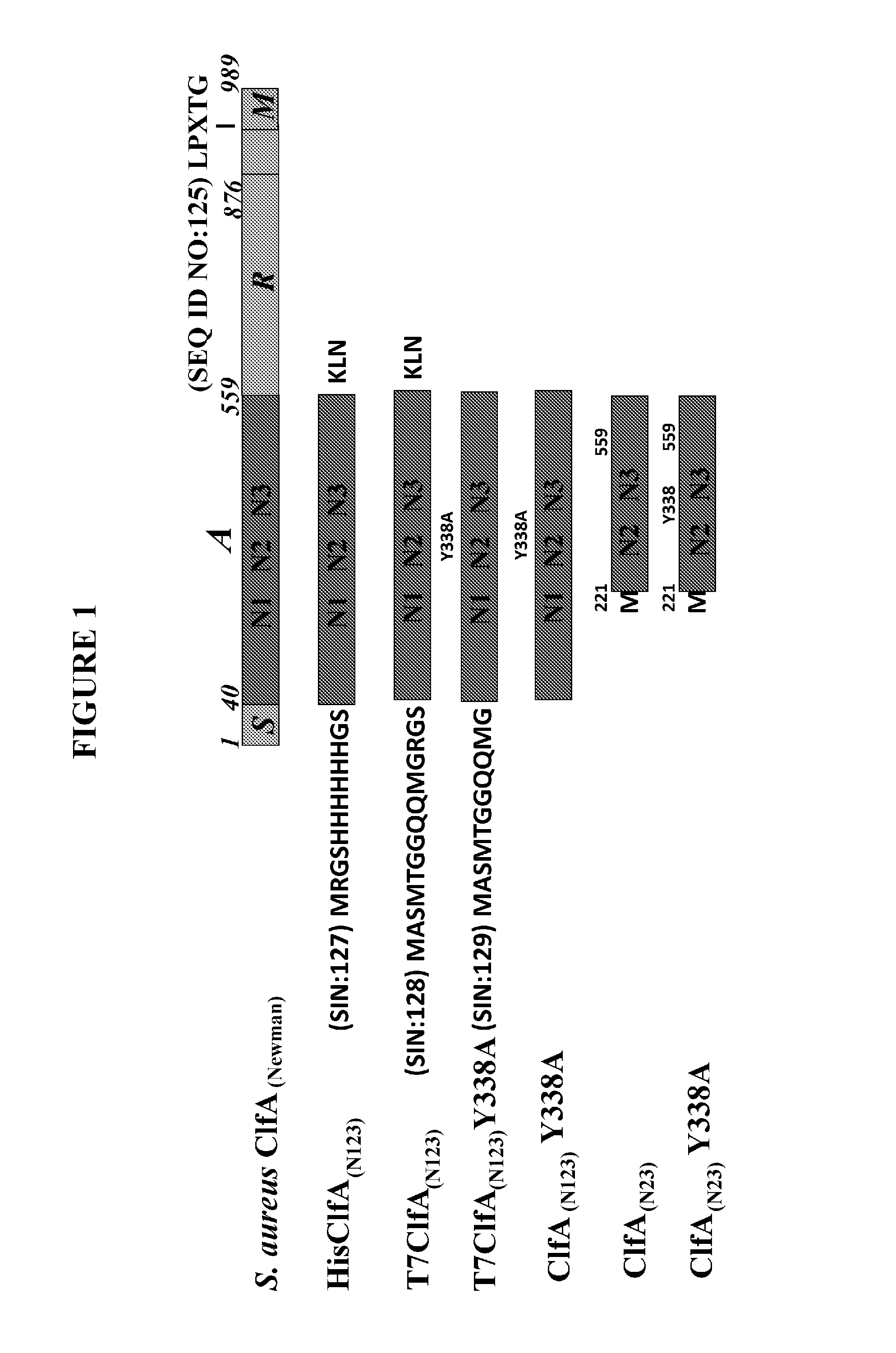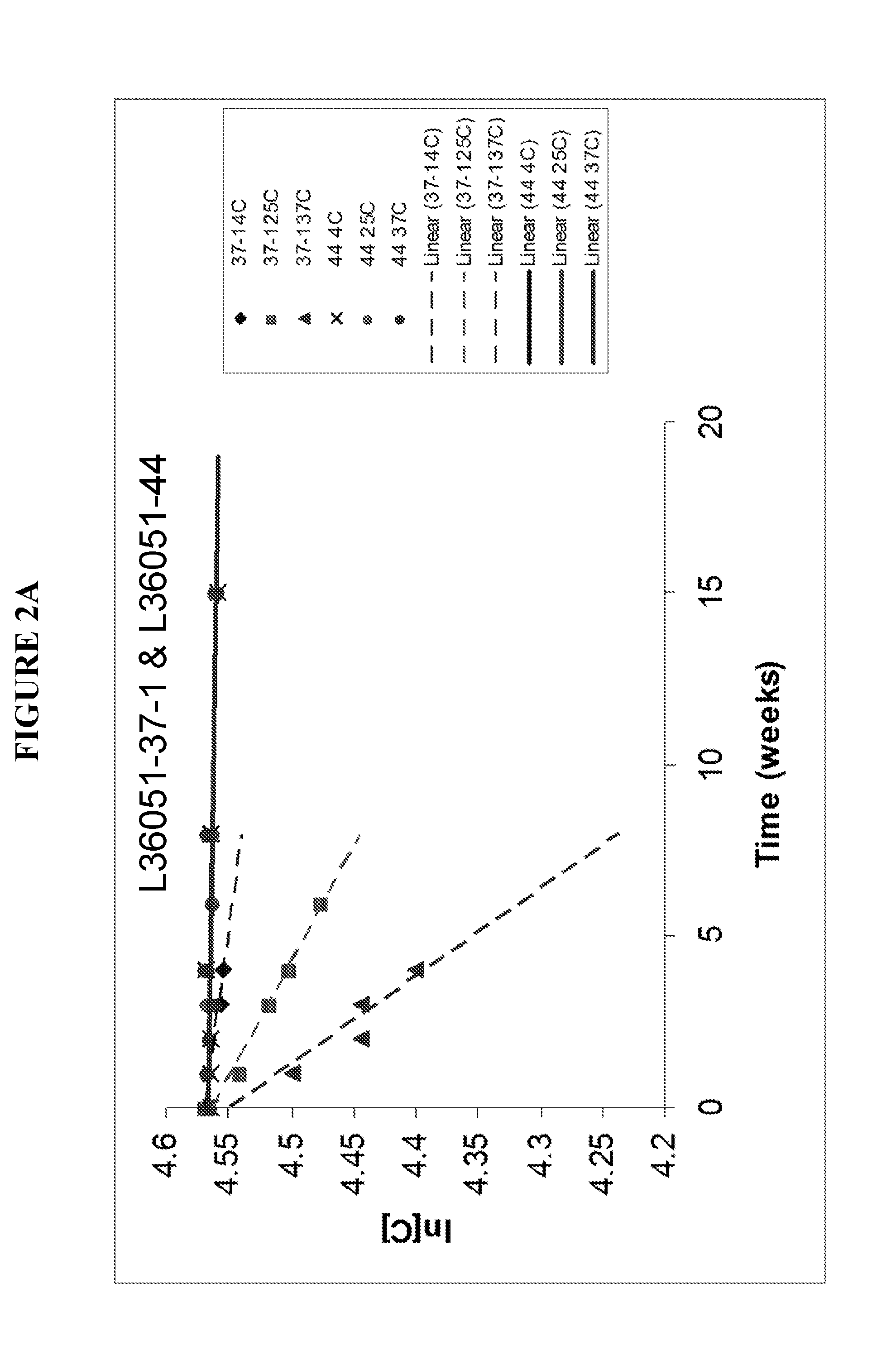Stable Immunogenic Compositions of Staphylococcus Aureus Antigens
a technology of immunogenic compositions and staphylococcus aureus, which is applied in the field of stable immunogenic compositions of staphylococcus aureus antigens, can solve the problems of phagocytosis, bacteria without capsules are more susceptible to phagocytosis, and protein instability in solution, so as to prevent, reduce the severity, or delay the onset of a disease.
- Summary
- Abstract
- Description
- Claims
- Application Information
AI Technical Summary
Benefits of technology
Problems solved by technology
Method used
Image
Examples
example 1
Preformulation Methodology
[0279]A variety of biophysical tools (derivative UV absorption spectroscopy, fluorescence spectroscopy, circular dichroism (CD) and differential scanning calorimetry (DSC) were used to examine the intrinsic characteristics of Staphylococcus aureus clumping factor A (ClfA) protein in the context of structural stability. Temperature and pH were the variable parameters used to exert stress on the protein to help characterize the intrinsic structural behavior of ClfA protein. This data was then used to screen for excipients that may provide additional stability to the protein. Furthermore, binding studies were performed to assess the dose- and pH-dependent affinity of ClfA to AlPO4 and Al(OH)3. The data disclosed herein were used to arrive at a formulation for ClfA for use in biomedical applications, such as, e.g., as a vaccine or immunogenic composition.
[0280]While the invention is directed to any and all clumping factor A (ClfA) proteins and formulations cont...
example 2
Preformulation of a ClfA Drug Product: Results
[0290]Pharmaceutically relevant stresses of temperature (10-85° C.) and pH (4.0-8.0) were exerted on the drug product (liquid formulated ClfA) and drug substance (unformulated ClfA protein in liquid phase) to identify their susceptibilities.
[0291]Intrinsic tryptophan fluorescence thermal melt studies were conducted on ClfA samples at various pHs from pH 4.0 to pH 8.0 and fluorescence emission curves were generated. For these experiments, the ClfA was generally at a concentration of 0.1 mg / ml-0.2 mg / ml. The inflection points of each curve were identified to be the melting temperature (Tm) and were tabulated in Table 4. At 10° C., the samples at higher pH values showed peak positions at higher wavelengths, suggesting that the tryptophan residues were more exposed to the solvent. Moreover, at higher pH values, ClfA exhibited lower Tm values indicating less stability compared to lower pH values such as pH 5.5 and 6.0. A pH panel at finer inc...
example 3
Formulation of a ClfA Lyophilized Drug Product: Summary
[0306]ClfA is generally considered to be an unstable protein, which means that it readily undergoes hydrolysis or “clipping” between the N1 domain and the N2 domain to generate at least two fragments, one of which contains the N1 domain and another which contains the N2N3 domains. By stability, what is meant is the relative amount of unhydrolyzed ClfA that contains substantially undegraded ClfA compared to degradation products, which include, for example, N1 and N2N3 peptide fragments. The greater the relative amount of substantially undegraded ClfA, the more stable the protein.
[0307]It was observed that the ClfA protein in a liquid formulation (supra) suffered from clipping between the N1 and N2N3 domains, as seen with size exclusion HPLC. After screening with carefully chosen excipients, lyophilization was investigated as an alternative to the liquid formulation based on liquid instability. Four lots of ClfA drug substance wer...
PUM
| Property | Measurement | Unit |
|---|---|---|
| w/w | aaaaa | aaaaa |
| concentration | aaaaa | aaaaa |
| concentration | aaaaa | aaaaa |
Abstract
Description
Claims
Application Information
 Login to View More
Login to View More - R&D
- Intellectual Property
- Life Sciences
- Materials
- Tech Scout
- Unparalleled Data Quality
- Higher Quality Content
- 60% Fewer Hallucinations
Browse by: Latest US Patents, China's latest patents, Technical Efficacy Thesaurus, Application Domain, Technology Topic, Popular Technical Reports.
© 2025 PatSnap. All rights reserved.Legal|Privacy policy|Modern Slavery Act Transparency Statement|Sitemap|About US| Contact US: help@patsnap.com



